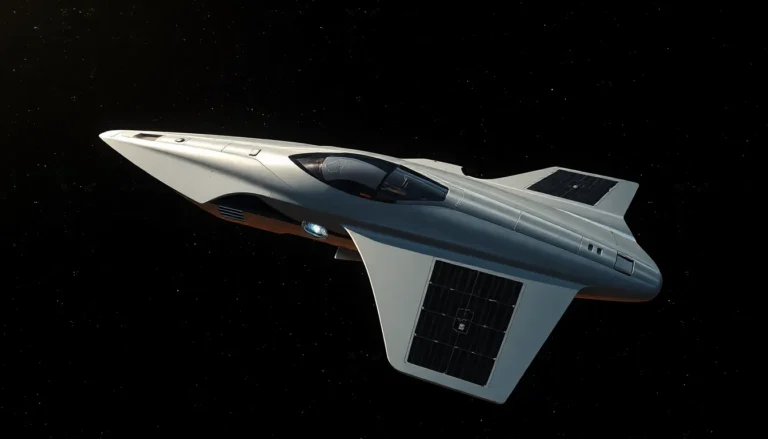Table of Contents
ToggleImagine if you could keep an eye on the entire planet without ever leaving your couch. Thanks to earth observation technology, that dream is a reality! This innovative field harnesses satellites, drones, and a sprinkle of high-tech wizardry to monitor everything from climate change to urban growth. It’s like having a superhero sidekick that tracks the health of the Earth while you binge-watch your favorite shows.
Overview of Earth Observation Technology
Earth observation technology plays a crucial role in monitoring and analyzing the Earth’s surface and atmosphere. It leverages satellites and drones, utilizing cutting-edge tools to assess environmental changes, urbanization patterns, and other significant global phenomena.
Definition and Importance
Earth observation technology encompasses systems and methods for gathering data regarding the Earth’s physical state. This technology is vital in addressing climate change, natural disasters, and resource management. Utilizing satellite imagery enables scientists to track deforestation, monitor agricultural health, and assess water resources. Data acquired through this technology supports informed decision-making, enhancing disaster preparedness and climate adaptation strategies. Thus, it significantly contributes to sustainable development initiatives and environmental protection efforts.
Historical Development
The roots of earth observation technology trace back to the early days of space exploration. In 1960, the launch of the first weather satellite, TIROS-1, marked a significant milestone. Advancements occurred throughout the 1970s and 1980s, highlighted by the deployment of Landsat satellites, which provided detailed images of land use changes. The establishment of the European Space Agency in 1975 further propelled developments in remote sensing technology. Recent years have witnessed a surge in drone technology, making earth observation more accessible and efficient. Enhanced imaging capabilities and data processing techniques now allow for real-time monitoring of various environmental challenges.
Types of Earth Observation Technology
Earth observation technology encompasses several key types that enhance our understanding of the planet. These technologies play a vital role in data collection, offering insights into various environmental issues.
Satellite Imagery
Satellite imagery provides comprehensive visuals of the Earth’s surface. High-resolution images capture detailed information on land use, vegetation, and water bodies. Various types of satellites orbit the Earth, such as geostationary and polar-orbiting satellites. Such imagery supports diverse applications, like precision agriculture and urban planning. Users can analyze changes over time, monitoring deforestation and urban sprawl effectively. Leading organizations, including NASA and the European Space Agency, utilize satellite imagery to facilitate critical research and policymaking.
Remote Sensing
Remote sensing employs sensors on satellites and airborne platforms to gather data about the Earth’s surface and atmosphere. This technology captures electromagnetic radiation reflected from terrestrial objects, such as soil and water. Instruments can determine temperature variations, land surface changes, and atmospheric conditions. By integrating remote sensing data with geographic information systems (GIS), users can generate valuable insights. Applications span climate monitoring, disaster response, and resource management. Remote sensing continues to evolve, improving spatial resolution and data accuracy through technological advancements.
Applications of Earth Observation Technology
Earth observation technology serves numerous applications crucial for understanding and managing the planet. Its diverse utility spans environmental monitoring, urban planning, and disaster management.
Environmental Monitoring
Environmental monitoring benefits greatly from earth observation technology. It allows scientists to track changes in ecosystems efficiently. Satellite imagery provides vital data on deforestation, enabling timely interventions. Monitoring air quality helps identify pollution sources in cities, enhancing public health measures. Data gathered assists in analyzing climate variability, offering insights into long-term trends. Remote sensors detect land cover changes, aiding conservation efforts worldwide. Various applications emerge from these capabilities, underscoring the significance of continuous monitoring.
Urban Planning
Urban planning integrates earth observation technology to enhance decision-making processes. Planners leverage high-resolution satellite imagery to visualize urban sprawl effectively. This technology supports zoning analysis, helping identify suitable locations for infrastructure development. Assessing land use patterns with real-time data fosters sustainable growth in cities. Planners can visualize heat islands and access to green spaces, promoting healthier environments. Integrating this data enhances collaboration among stakeholders, driving informed policy decisions that benefit local communities.
Disaster Management
Disaster management employs earth observation technology to improve preparedness and response efforts. Analyzing satellite images facilitates the early detection of natural disasters, such as hurricanes and floods. This technology aids in real-time monitoring of affected regions, allowing for timely resource allocation. Assessing damage through high-resolution imagery accelerates recovery operations, minimizing economic losses. Coordinating efforts among emergency services relies on this data, enhancing their ability to save lives. By utilizing these insights, response strategies become more effective and organized.
Challenges and Limitations
Earth observation technology presents various challenges and limitations that impact its effectiveness and adoption. Understanding these issues is crucial for addressing them and enhancing the technology’s potential.
Data Privacy Concerns
Data privacy remains a significant challenge in earth observation. Collecting satellite and drone imagery can inadvertently capture private properties and individuals. Regulations may not always keep pace with technology advancements, causing legal and ethical dilemmas. Organizations must navigate complex laws and regulations while ensuring compliance with data protection standards. Moreover, public perception of surveillance often leads to resistance against technologies that rely on extensive data collection. Addressing these concerns involves implementing robust privacy measures and fostering transparency in data usage.
Accessibility Issues
Accessibility issues also hinder the widespread adoption of earth observation technology. High costs associated with satellite launches and advanced drones limit access for smaller organizations and developing nations. Additionally, technical expertise required to analyze collected data poses another barrier. Individuals and communities without adequate training and resources struggle to leverage these powerful tools. Internet connectivity remains a critical factor, as remote areas often lack the necessary infrastructure. Fostering partnerships and providing training opportunities can help mitigate these accessibility challenges and enhance the technology’s reach.
Future Trends in Earth Observation Technology
Earth observation technology continues to evolve, presenting new opportunities for environmental monitoring and management. Upcoming advancements focus on sensor technology and artificial intelligence.
Advancements in Sensor Technology
Innovation in sensor technology enhances data collection capabilities. Miniaturization of sensors allows for deployment on smaller platforms, including drones. Sensors now provide higher resolution imagery, improving the accuracy of environmental assessments. Enhanced multispectral and hyperspectral sensors enable comprehensive monitoring of vegetation health and water quality. Satellite platforms benefit from upgraded sensors designed for task-specific missions, such as disaster response and climate monitoring. New technologies like synthetic aperture radar contribute to terrain mapping under various weather conditions. These advancements make it easier to gather crucial data for addressing ecological challenges.
Integration with AI and Machine Learning
Artificial intelligence plays a pivotal role in processing and analyzing earth observation data. Machine learning algorithms identify patterns within vast datasets, enhancing forecast accuracy for climate events. Integration simplifies the interpretation of complex data from sensors, allowing for real-time insights into environmental changes. AI tools facilitate predictive modeling, helping to anticipate the impact of natural disasters. Natural language processing systems improve communication of findings to non-specialist stakeholders, fostering broader understanding. Coupled with data from various sensors, AI enhances decision-making in urban planning and resource management. Overall, the synergy of AI with earth observation technology drives significant advancements in efficiency and efficacy.
Conclusion
Earth observation technology stands as a vital tool in understanding and addressing the complexities of our planet. Its ability to provide real-time data on environmental changes empowers individuals and organizations to make informed decisions. As advancements continue to unfold the integration of AI and improved sensor technology will only enhance its capabilities.
The ongoing evolution of this technology promises to address pressing global challenges more effectively. By fostering collaboration and investing in training, the benefits of earth observation can reach wider audiences. Embracing this technology will enable better management of resources and contribute to a more sustainable future for all.







